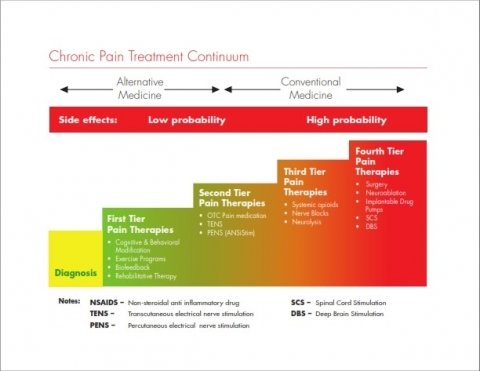
If you’ve been suffering from chronic pain, the chances are that you haven’t seen a pain specialist. In fact, you may not even be aware of your treatment options beyond medication or surgery. Studies have shown that many patients don’t know what’s available. Unfortunately, as a result, many patients may not have sought treatment.
But there are many alternatives based on the type of pain and cause. They start from non-invasive options such as exercise or cognitive therapy to involved techniques such as deep brain stimulation.
We’ve put together a comprehensive guide to help patients learn about what treatments are available from the least to the most invasive.
First Tier Pain Therapies
- Cognitive and behavioral modification Chronic pain is a tremendous psychological burden, and the way people respond to and tolerate pain depends on factors including their personality, culture and past pain experiences. With cognitive and behavioral therapies, these factors are considered to help patients learn new skills and strategies for dealing with chronic pain, such as relaxation techniques and visualization exercises. Yoga and meditation fall under this category.
- Exercise programs One of the first treatments for chronic pain may be light exercise, such as walking. Exercise stimulates the release of the body’s natural pain relievers called endorphins. Exercise can release natural pain relievers to promotes strength and endurance while reducing stress. Exercise also strengthen unused or weak muscles to compensate for an overworked muscle that is causing pain.
- Biofeedback The patient learns to identify and relax specific muscles. This can help to relieve the discomfort of conditions like low back pain, abdominal pain, temporomandibular joint disorders and fibromyalgia.
- Rehabilitative therapy This includes physical therapy, occupational therapy, massage therapy and chiropractic therapy to reduce pain and increase function. Rehabilitative therapy is an important part of early pain treatment and is often combined with other treatments such as medications.
Second Tier Pain Therapies
- Over-the-counter pain medications These types of medications may be useful to for early treatment for pain and include an over-the-counter analgesic such as aspirin or Acetaminophen and anti-inflammatory agents such as ibuprofen.
- Transcutaneous electrical stimulation (TENS) InTENS therapy electrical pulses are applied to nerve endings through electrodes placed on the skin over the painful area. Researchers theorize that these pulses temporarily interrupt the transmission of pain signals from small sensory nerves at the site of the pain. TENS may also stimulate the release of endorphins, which relieve pain and produce feelings of well-being.
- Auriculotherapy a.k.a. Percutaneous electrical stimulation In PENS therapy (as personified by the Primary Relief®) electrical pulses are applied to nerve endings in the ear. PENS also releases endorphins, which relieve pain. Researchers theorize that repeated application of this treatment achieves neuroplasticity and prevents the brain from sending out false pain signals.
Third Tier Pain Therapies
- Systemic opioids Powerful pain medications known as opioids are often prescribed when severe chronic pain does not respond to level one and level two therapies. Opioids can effectively relieve the most severe pain.
- Nerve blocks This involves applying a local anesthetic or steroids are applied directly to the nerve causing the pain. Nerve blocks may relieve pain temporarily by having a numbing effect or by decreasing the swelling of tissues around the nerve.
- Neurolysis A chemical or extreme temperatures may be used to stop a nerve from sending pain signals to the brain.
Fourth Tier Pain Therapies
- Surgery A surgical solution may be performed to repair or correct an anatomical defect or a defect due to an illness or injury. Surgery may also be performed on a nerve to interrupt the transmission of pain signals.
- Neuroablation This surgical technique permanently blocks nerve pathways to the brain by destroying the nerves and tissue at the source of the chronic pain. Several procedures are used, including cordotomy, in which a surgeon cuts a tract of the spinal cord, rhizotomy, in which a surgeon destroys a specific nerve near the spinal cord, and thalamotomy, in which a surgeon uses radiofrequency energy to heat and destroy specific cells deep in the brain.
- Neuromodulation These are implantable therapies for the management of chronic pain including drug administration systems (drug pumps), (SCS) spinal cord stimulation, (PNS) Peripheral Nerve stimulation and (DBS) Deep Brain stimulation. They work by applying an electrical current to the source of chronic pain. This creates a pleasant sensation that blocks the brain's ability to sense the previously perceived pain.

